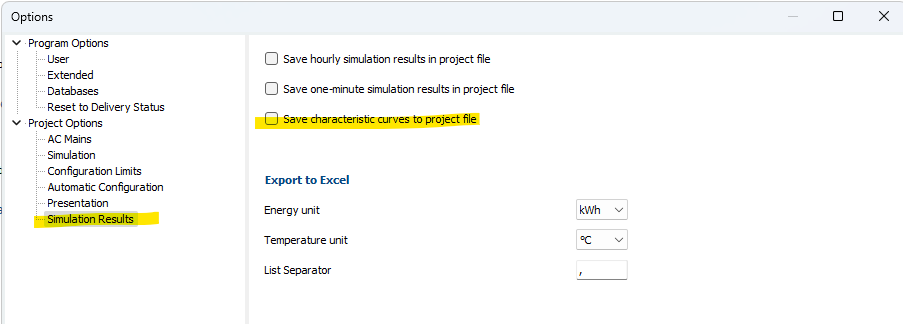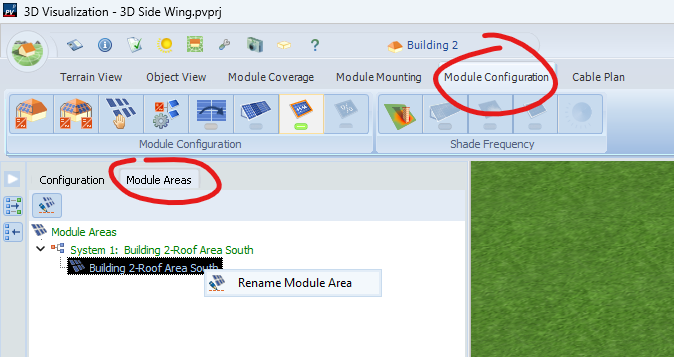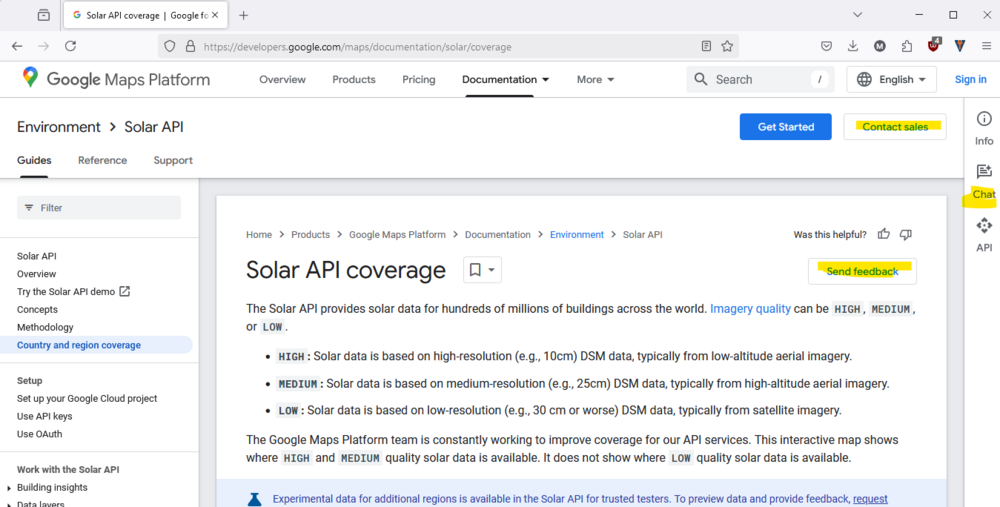-
Posts
1,845 -
Joined
-
Last visited
-
Days Won
172
Everything posted by developer_mh
-
Hi Will Yang, in PV*SOL the manufacturers enter the data for the components like PV modules themselves. Please feel free to contact our database team via database@valentin-software.com, they can create a login for you. This is the site where you can enter the data once you have a login: https://pvsol-database.valentin-software.com/ Best regards, Martin
-
Hi Vitor, I will notify our database team so that they can include the data in one of the next updates. Kind regards, Martin
-
Hi Jordan, you can enter the limits for the voltage and current limit calculations in the options: https://help.valentin-software.com/pvsol/en/pages/inverters/configuration-limits/ For the open circuit voltage we use the simple equation with the temperature coefficient alpha_U, see formula 11 here on this page: https://help.valentin-software.com/pvsol/en/calculation/pv-modules/characteristic-curve-models/ Hope that helps, kind regards, Martin
-
Hi Gordana, you can import 3D models in PV*SOL, no problem. You can also import terrain data via the Google Solar API. But the design of real large scale solar plants on uneven terrain is not what PV*SOL is made for. Best regards, Martin
-

3D Planungssoftware Aktualisierung
developer_mh replied to Projektentwicklung_1PUNKT5's topic in PV*SOL
Hallo Rieke, ja, wir sind nach wie vor an einer Aktualisierung der 3D-Umgebung, und tatsächlich nach wie vor mit Hochdruck. Wir sind uns der Tatsache bewusst, dass das nach außen etwas komisch wirken muss, dass wir so lange an dieser Neu-Entwicklung arbeiten. Es ist eine Großbaustelle, die wie alle Großbaustellen viele Resourcen bindet, viel Nerven und Zeit kostet, mit vielen Höhen und Tiefen, aber wir sind zuversichtlich, dass wir auf einem guten Weg sind. Ich kann aber leider keine Info darüber geben, wann es soweit sein könnte, dass wir releasen können. So leid es mir tut. Wir sind überaus dankbar für unsere vielen Kunden, die uns trotzdem treu sind, und versuchen in der Zwischenzeit, die bestehende 3D-Umgebung auch noch weiter mit Updates zu versorgen (siehe z.B. die Integration der Google Solar API, oder jetzt gerade in 2025 R6 die Schnittstelle zum Renusol PV Configurator). Es freut uns natürlich zu hören, dass so viele gerne unsere Software nutzen, und umso mehr würden wir uns wünschen, ihnen endlich die Neu-Entwicklung vorstellen zu können. Aber da müssen wir uns leider noch etwas in Geduld üben. Beste Grüße, Martin -
Hi BAR, in PV*SOL there is no such parameter as the loss due to the unavailability of the plant. Do you refer to inverter or grid failures or similar? Best regards, Martin
- 1 reply
-
- losses
- anti-spill
-
(and 2 more)
Tagged with:
-
Hi Ryan, in addition to the two methods you already mentioned (predefining the sort order in the small menu on the bottom left and manually sorting them by dragging), you can draw the cables with a pen in the cable plan section. Aufzeichnung 2025-05-06 144413.mp4 I made a small screen cast to show what I mean. If that is not what you are looking for, please feel free to ask. Kind regards, Martin
-

Akku gibt über verschiedene Zeiträume nicht volle Leistung ab
developer_mh replied to Raffael PV's topic in PV*SOL
Hallo Raffael, ich konnte mir dein Projekt jetzt anschauen. Da ist wohl leider ein Bug in der Ermittlung der maximalen Entladeleistung reingekommen. Es wird hier tatsächlich unter Umständen der in der Zeitsteuerung eingetragene Maximal-Wert genommen, auch wenn das zeitgesteuerte Entladen deaktiviert ist. Den Fehler werden wir mit dem nächsten Release beheben. Als Workaround bis dahin kannst du einfach den Wert bei der zeitgesteuerten Entladung entsprechend hochsetzen (und dann die Funktion wieder deaktivieren), dann sollte das auch funktionieren. Entschuldigung und vielen Dank fürs Melden! Martin -
Hi Tade, I can confirm this error. It will be fixed in the next release. Thank you for reporting this! Kind regards, Martin
-

New release, can't save PV*Sol file, reason unknown.
developer_mh replied to Nils Torbjørn's topic in PV*SOL
I thought it was a file that you already had from a previous version of PV*SOL premium. If it is a fresh file created in R4, then try disabling the option to save the characteristics in the options: We are really sorry for the inconvenience caused by this. We had to replace a zipping library in our code, and apparently the new one behaves odd in various ways that we didn't see in our tests. Best regards, Martin -

New release, can't save PV*Sol file, reason unknown.
developer_mh replied to Nils Torbjørn's topic in PV*SOL
Hi hom, could you send us the project file that you are unable to save in R4, please? You can send it here by private message or to hotline@valentin-software.com (then with a hint to them, that they shall forward the project file to me). Thanks, Martin -
Hi Henrique, could you provide a project file please? You can send it to hotline@valentin-software.com or send it here by private message. Thanks and kind regards, Martin
-

New release, can't save PV*Sol file, reason unknown.
developer_mh replied to Nils Torbjørn's topic in PV*SOL
Hi Nils, sorry, I forgot the s in the link above, it must be https instead of http, of course. https://downloads.valentin.de/pvsol/setup_pvsolpremium_2025_2.exe The default name of the module area comes from the building name plus the roof surface name. Depending on the GUI language that you use, or also the file names of 3D models or so, this might already lead to those characters. If you use English as GUI language and the module area name does not contain any of those special letters with diacritics, and you are still not able to save the files, it would be very helpful for us if you could let us know (and send over the project file). Best regards, Martin -

New release, can't save PV*Sol file, reason unknown.
developer_mh replied to Nils Torbjørn's topic in PV*SOL
Hi Nils, yes, you can go back to R2 if you like: http://downloads.valentin.de/pvsol/setup_pvsolpremium_2025_2.exe We have already identified the cause of the error and will release a fix for that as soon as possible. The renaming of the module areas should be done here: Then go back from the 3D environment, and then you should be able to save again. As far as we know right now, all consonant letters with diacritics, e.g. ś or ć, need to be replaced. Best regards, Martin -
Hi Witanak, it is correct, the Victron inverters are still missing in the database. This is mostly due to the different operation mode in which the Victron devices are working. As long as we can't simulate that behaviour correctly, we prefer not to include them. But be assured that we have it on our list. Thanks and kind regards, Martin
-
Hi FrRö, thank you for your message. No, we weren't able to develop this any further, sorry. Right now the process of optimizing the systems for the customer remains a manual task - but we have it on our list to provide some kind of tools to make it easier for the planner to do so. All the best for you as well, kind regards, Martin
-
Hallo, sollte wieder laufen. Bitte die Unannehmlichkeiten zu entschuldigen. Viele Grüße, Martin
-
Hallo, danke für die Meldung. Es gibt seit ca. 14h heute Probleme mit dem Server, über den wir uns mit der Google Solar API verbinden. Wir haben die Ursache jetzt (hoffentlich) identifiziert und arbeiten an einer Lösung. Ich werde hier schreiben, sobald wir das Problem lösen konnten. Beste Grüße, Martin
-
Hallo Harald, das sind jetzt einige Themen und Fragen, ich versuche mal der Reihe nach darauf einzugehen. Hierbei auch immer das vermeintlich Selbstverständliche beachten: Die Klimadaten, mit denen simuliert wird, sind natürlich etwas anderes als die live in der Praxis gemessenen Werte. Aber abgesehen davon, kann man schon eine in der Praxis gebaute Anlage auf diese Weise nachrechnen. Man darf eben nur die Werte auf Stunden- oder Minutenbasis vergleichen. Zu den Abschattungswerten: Das trifft es nicht ganz. Die modulunabhängige Abschattung ist sozusagen der kleinste gemeinsame Nenner über alle Diffusabschattungswerte der Module. Die Werte können für jedes Modul unterschiedlich sein, wenn jedes Modul einen etwas anderen Teil des Himmels sieht. Dabei spielt die Modulneigung und -ausrichtung eine Rolle, auch die Horizontlinie und nahe abschattende Objekte wie Aufbauten oder auch Nachbargebäude. Der gleichförmige Teil der Diffusabschattung wird der modulunabhängigen Abschattung zugerechnet, der Rest der modulspezifischen. In die modulspezifische Abschattung fließt dann natürlich auch alles an Direktverschattung ein. Daraus ergibt sich auch, dass die modulunabhängige Abschattung sehr klein werden kann, wenn die Diffusabschattung auf den Modulen stark unterschiedlich und bei einem Modul sehr gering ist. Dafür würde in diesem Fall die modulspezifische Abschattung höher ausfallen. Zu beachten ist, dass sich die Verluste der modulabhängigen Abschattung auf die Strahlung in kWh/m² beziehen, während die modulspezifischen Verluste elektrische Verluste in kWh darstellen. Das hast du schon verstanden, wie ich deinem Post entnehmen kann, ich schreibe es nur nochmal für alle anderen mit dazu. Direkt addieren kann man die beiden Größen nicht, da vor allem im mittleren Block der Energiebilanz alles stark voneinander abhängt und sie an verschiedenen Positionen in der Energiebilanz auftauchen. Ja, doch, das kann schon sehr gut sein. Gerade, wenn die Abschattung vor allem bei niedrigen Sonnenständen stattfindet. Man kann sich das anhand der Stundenwerte aber auch gut nachrechnen, wenn einen das so sehr interessiert. Einfach mal das Projekt mit Abschattung rechnen, Stundenwerte (z.B. der PV Energie am WR Eingang) exportieren, dann Schatten ausschalten, wieder simulieren, wieder Werte exportieren und dann vergleichen. Meine Erklärung weiter oben bringt da hoffentlich Klarheit. Startspannung: Korrekt, die wird derzeit nicht berücksichtigt. Es wird jedoch die minimale Einspeiseleistung berücksichtigt, sowie die untere MPP-Spannungs-Grenze. Ich würde mal davon ausgehen, dass bei einem ordentlich dimensionierten Strang der Fehler nicht allzu groß ist. Was meinst du denn mit Voltage Blocking? Ich habe gerade deine Projektdatei nicht vorliegen, ich schau morgen nochmal rein, vielleicht seh ich da noch mehr. Beste Grüße, Martin
- 6 replies
-
- teilabschattung
- modulspezifisch
-
(and 1 more)
Tagged with:
-
Hi Dunext, thank you for your inquiry, and a happy new year! As a manufacturer you can get an account for our online database in order to add your products there. They will be automatically provided to the users in regular database update intervals. Please head over to https://pvsol-database.valentin-software.com/, for more info and the contact for getting an account. Kind regards, Martin
-

Solar API funktioniert bei Qualitätsstufe MEDIUM nicht
developer_mh replied to PH2's topic in PV*SOL
Hallo Harald, ich habe auch nur die hier angebotenen Kontakt-Möglichkeiten: Genutzt hatte ich den "Send Feedback" Button. Beste Grüße, Martin -

Solar API funktioniert bei Qualitätsstufe MEDIUM nicht
developer_mh replied to PH2's topic in PV*SOL
Hallo PH2, nochmal zur Ergänzung: Wir können für einige wenige Gebiete bestätigen, dass die MEDIUM-Abdeckung nicht korrekt von Google angegeben wird. Es gibt z.B. einen größeren Fleck in Nordbayern, Deutschland, in dem gar keine Daten vorhanden sind, obwohl laut Karte welche da sein sollten. Wir haben das Problem an Google gemeldet, aber bisher noch keine Rückmeldung erhalten. Was bei solch großen Unternehmen vielleicht hilft, ist, wenn möglichst viele Kunden auf die Probleme aufmerksam machen. Also gerne auch nochmal selbst bei Google Bescheid geben, das wäre super. Danke fürs Melden jedenfalls, beste Grüße, Martin -
Hallo Hausdach, danke für die Nachricht, wir leiten das ans Datenbank-Team weiter. Beste Grüße und einen guten Start in die Woche, Martin
-
Hallo PH2, ein gesundes neues Jahr noch! Das ist richtig, es gibt derzeit keine (einfache) Möglichkeit, ein Lastprofil selbst zu verwenden, das von Dritten angelegt wurde. Auch eine Export-Möglichkeit gibt es nur bedingt. Was man machen kann: Nach der Simulation zum CSV-Export auf der Präsentationsseite gehen und sich dort den Verbrauch exportieren Am besten ohne Monats- und Jahreswerte auf den Zeitstempel achten: Wenn das Lastprofil in 1min-Auflösung vorliegt, aber mit 1h-Auflösung simuliert wurde, bekommt man auch nur das 1h-Profil exportiert Die csv in Excel oder LibreOffice Calc öffnen und die Datumsspalte entfernen In PV*SOL importieren. Beste Grüße und einen guten Start in die Woche, Martin
- 1 reply
-
- lastrprofil
- import
-
(and 1 more)
Tagged with:
-

Screenshots der Modulflächen in 3D nicht zuordenbar
developer_mh replied to Thomas Fröschl's topic in PV*SOL
Hallo Thomas Fröschl, in der Regel kann man den Fehler genau so beheben, wie es da vorgeschlagen wird. In die 3D Visualisierung gehen und wieder zurück, dann sollte die Zuordnung wieder stimmen. Wenn das nicht klappt, gerne das Projekt schicken an unseren technischen Support: https://valentin-software.com/support/technischer-support/ Für dieses Jahr wird das aber aller Voraussicht nach nichts mehr. Beste Grüße, Martin





